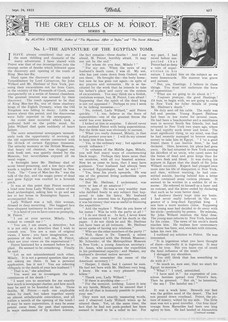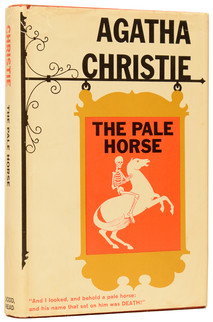Mystery & Menace: Christies for Hallowe'en.
- David Morris
- Oct 22
- 5 min read
As we approach Hallowe'en, a date gaining global popularity, the northern hemisphere is seeing autumnal shadows lengthen and the air turning cooler. At this time of year readers often crave stories tinged not just with mystery, but with menace and the macabre. While Agatha Christie is well known for her excellent puzzle mysteries, her vast canon contains stories that are surprisingly well-suited to Hallowe’en—where the line between rational deduction and eerie suggestion begins to blur.
These stories reveal that Christie’s genius lies not only in plotting, but in her mastery of mood. Her stories often hinge on hidden motives, buried secrets, and the fear of the unknown, all of which are perfect ingredients for a Hallowe’en read. However, unlike traditional horror stories, her tales offer resolution: a return to order after chaos, which makes them as satisfying as they are spooky. So, whether it’s a séance gone wrong, a murder cloaked in superstition, or a detective who must navigate both logic and legend, Christie has many stories that offer a bit of spine-tingling fun for those who prefer their chills with a touch of class.
My Picks.
So, what is my short list for recommended Christie reads this Hallowe’en? Though Hallowe’en Party (first published in 1969) may seem an obvious pick, its tone is more procedural than atmospheric. The murder of a child at a festive gathering is undeniably grim, but the novel’s focus remains squarely on Poirot’s methodical unraveling of clues rather than on eerie ambiance or supernatural suggestion so it hasn't made my list. If you are interested in learning more about that novel, my article dedicated to it can be accessed via this link.
For readers seeking a more haunting experience (and nothing's in Venice!), the five short stories, two novels and one play discussed below hopefully offer a more evocative fit. I have no doubt my list will generate opinions (as all lists do), so do add your own thoughts or choices in the comments!
The Adventure of the Egyptian Tomb.
This short story was first published in The Sketch in September 1923, and then in 1924 as part of the collection Poirot Investigates. This story finds members of an archaeological expedition dying mysteriously, with whispers of a pharaoh’s curse. Poirot, ever the rationalist, must untangle myth from murder. Images below include the first appearance in The Sketch, the first Pan paperback (it wasn't published by Fontana), and both the British and American first editions (note it is a 2nd state jacket on the British first).
The Hound of Death.
This titular story from the 1933 collection The Hound of Death and Other Stories is steeped in the supernatural. The tale explores psychic powers, wartime trauma, and a chilling climax that defies explanation. It’s one of Christie’s rare forays into horror—and it lingers. Below is a slide from a talk I gave where I talked about the likely inspiration for a number of Christie's stories. Images of the book are provided below the next selection.

The Last Séance.
Also first published in 1933 in The Hound of Death and Other Stories, this story tells of a medium’s final performance that leads to tragedy. It’s a haunting tale of grief, illusion, and the dangers of meddling with the unknown. Images below include the Pan, Fontana and Albatross paperbacks - the latter with the error spelling of the title. Last, it the British first edition - a fairly common printing by Odhams Press.
The Mystery of the Blue Jar.
First published in 1934 as part of The Listerdale Mystery, this short story tells of a young man who hears ghostly cries from a garden—and becomes obsessed with solving their origin. Christie plays with perception and psychological suspense exceptionally well in this atmospheric gem. The images below include a series of Fontana paperbacks - including the covers by Ian Robertson & Tom Adams, as well as the quite scarce television tie in. Lastly, but not least, is the very rare British first - a Collins Mystery imprint (not Crime Club). There was no American equivalent printing.
The Wife of the Kenite.
This story remained uncollected in a book omnibus for most of its life. It was first published in an Australian magazine, The Home, in 1922 and is one of Christie’s earliest short stories. This tale draws on biblical allusion and psychological tension in which a woman’s quiet resolve and cryptic motivations build toward a chilling act of vengeance. It is a stark and haunting piece that showcases Christie’s range beyond traditional detective fiction. The images below show that first true printing, plus the short-story collection it can now be found in.
The Pale Horse.
This full-length novel was first published in 1961. In it, Christie skillfully blends occult elements with a murder conspiracy. With witches, death rituals, and a protagonist unsure of what’s real, it’s a great Christie for this time of year. The images below include two Fontana paperbacks - one with cover art by Ian Robertson and one by Tom Adams (bat) - plus the British and American first editions.
Endless Night.
This is one of my personal favourite Christie novels. It was initially published in 1967 and features a sinister house, a cursed plot of land, and a narrator whose charm masks something darker. Arguably Christie’s finest gothic thriller, it unfolds like a modern folktale. Set at Gypsy’s Acre, where omens and whispers turn deadly, it’s a slow burn into madness and murder. Perfect for readers who like their chills psychological and their twists cruel. The images below include two Fontana paperbacks - Martin Baker's excellent cover and the film tie-in - as well as the British and American first editions.
The Rats.
My sense is that many fans of Christie often forget to read her plays. The Rats is one of her originals - not adapted from a story. It was first published by Samuel French in 1961 as one of three one-act plays which together were known as The Rule of Three. This is a stand-alone short play and does not need to be read with the other two parts of The Rule of Three, which are The Patient and Afternoon at the Seaside. The Rats is a taut psychological thriller about adultery, deception, and revenge, culminating in a chilling twist perfect for the season. Below are images of the cover of the first printing as well as the original set design.
How to Read Them.
All of the original sources are listed in each titles description. Beyond those sources or asking you local independent bookstore, the five short stories were collected in The Last Séance – Tales of the Supernatural (HarperCollins, 2019), which is a curated collection of 20 eerie tales. All the original novels and short story collections remain widely available both as new editions or used. The play, The Rats, can be ordered directly from Concord Theatricals, or found online.
Corrections & Input.
I always welcome corrections, updates or edits. If you think anything should be changed in this article please email me at: collectchristie@gmail.com .
Subscribe & the Socials.
If you are not a subscriber to my website, please consider subscribing here: link. This ensures you receive an email any time I write and post an article. Re: Social Media accounts - do consider following me on X (formerly Twitter) @collectchristie , on BlueSky @collectchristie.bsky.social and on Facebook. The content on X and BlueSky is usually identical, but will vary on Facebook. I am also now on Instagram. All should be of interest for any fan of Agatha Christie.
Happy Collecting!




















































